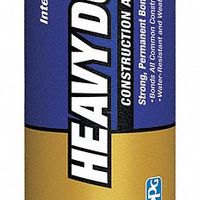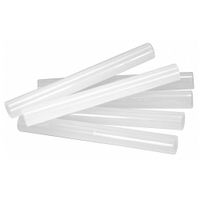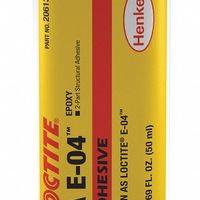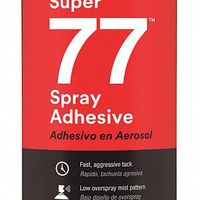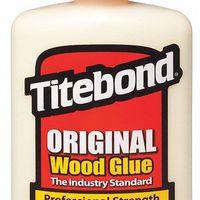Call +(254) 703 030 000 / 751 483 999 / 721 704 777
- Home
- Adhesives Sealants And Tape
- Adhesives Glues
.....Read More
Frequently Asked Questions
What is the strongest adhesive for bonding materials?
The "strongest" adhesive depends on the materials being bonded, the environmental conditions, and the application. For general-purpose strong bonding, structural adhesives like epoxies, polyurethanes, and acrylics are often used.
Epoxies are known for their high strength, durability, and resistance to chemicals and heat, making them suitable for metals, ceramics, and some plastics. Polyurethanes offer flexibility and excellent adhesion to a variety of substrates, including plastics, wood, and fabrics, and can withstand vibration and shock. Acrylics provide fast curing times and strong bonds to various plastics and metals.
For specific applications, other adhesives might be stronger. For instance, cyanoacrylates (super glue) offer very fast, strong bonds for small, non-porous surfaces. Anaerobic adhesives are strong for metal-to-metal bonding in the absence of air. Solvent cements chemically bond certain plastics by dissolving and fusing the surfaces.
Ultimately, the best adhesive is determined by the specific requirements of the bond.
How do you remove adhesive residue?
Removing adhesive residue can be achieved through various methods, depending on the type of adhesive and the surface it's on. For fresh, water-soluble glues like white school glue, warm water and a cloth are usually effective. For more stubborn residues, such as those from stickers, tape, or labels, a solvent is often necessary.
Common household items that can act as solvents include rubbing alcohol, nail polish remover (acetone-based), vinegar, or even peanut butter for particularly sticky messes on non-porous surfaces. Commercial adhesive removers are also available and are formulated to break down different types of glues.
When using any solvent, it's crucial to test it on an inconspicuous area first to ensure it doesn't damage or discolor the surface. Apply a small amount of the chosen remover to a clean cloth and gently rub the residue. For tougher spots, you might need to let the solvent sit for a few minutes to penetrate the adhesive before scrubbing. Always wipe away the residue and solvent with a clean cloth afterwards, and for some surfaces, a final rinse with water may be beneficial.
What is the difference between glue and adhesive?
Glue and adhesive are often used interchangeably, but there's a subtle distinction. "Adhesive" is the broader term, referring to any substance that can bond two surfaces together. This includes a wide range of materials, both natural and synthetic, such as epoxies, tapes, and various chemical compounds. "Glue," on the other hand, is a more specific type of adhesive, historically derived from natural sources like animal proteins or plant resins. While many modern glues are synthetic, the term often implies a viscous liquid or gel used for bonding. In essence, all glues are adhesives, but not all adhesives are glues.
How long does it take for adhesive to dry?
The drying time for adhesive can vary significantly depending on several factors, including the type of adhesive, humidity, temperature, and the porosity of the materials being bonded. For example, superglues (cyanoacrylates) typically dry within seconds, while wood glues can take 30 minutes to an hour to set and up to 24 hours to fully cure. Construction adhesives might require several hours to set and days to reach their maximum strength. It's always best to consult the manufacturer's instructions on the product packaging for specific drying and curing times.
Can adhesives be used on all surfaces?
Adhesives are versatile, but their effectiveness varies greatly depending on the surface. Factors like surface porosity, texture, and chemical composition play a significant role. For instance, porous surfaces like wood or fabric can absorb adhesives, creating a strong mechanical bond. Smooth, non-porous surfaces such as glass or metal, however, require adhesives that form a chemical bond or have strong intermolecular forces for adhesion.
The type of adhesive also matters. Some are formulated for specific materials, like cyanoacrylates (super glue) for quick bonds on many materials, or epoxies for high-strength, durable bonds on a wide range of substrates. Acrylic adhesives are often used for plastics, while silicone adhesives are excellent for flexible materials and sealing.
Surface preparation is crucial. Cleaning the surface of dirt, oil, and grease is essential for optimal adhesion. Sometimes, roughening a smooth surface or using a primer can also improve bond strength. Therefore, while adhesives can be used on many surfaces, it's vital to choose the right adhesive and prepare the surface appropriately for successful and lasting results.
What is the best adhesive for wood?
The "best" adhesive for wood depends on the specific application, as different glues offer various strengths, drying times, and resistances. For general woodworking and strong, permanent bonds, PVA (Polyvinyl Acetate) wood glue, often referred to as carpenter's glue or yellow glue, is a popular choice. It's easy to use, dries relatively quickly, and creates a bond stronger than the wood itself.
For projects exposed to moisture or outdoor conditions, waterproof options like Type III PVA glues (e.g., Titebond III) or polyurethane glue are excellent. Polyurethane glue offers high strength and versatility, bonding well to a variety of materials beyond wood, but it requires moisture to cure and can expand, which might necessitate clamping.
Epoxy is ideal for filling gaps, bonding dissimilar materials, or when maximum strength and water resistance are paramount. It consists of two parts (resin and hardener) that are mixed before application, offering a strong, rigid, and waterproof bond.
Hide glue, available in liquid or granular forms, is valued by furniture restorers and musical instrument makers for its reversible nature (it can be reactivated with heat and moisture), allowing for disassembly and repair.
Ultimately, choosing the best adhesive involves considering factors such as the type of wood, environmental exposure, desired drying time, and the specific structural requirements of the project.
How do you apply spray adhesive?
Spray adhesive is a versatile tool for many crafting, home improvement, and professional tasks. To use it effectively and safely, always start by ensuring good ventilation in your workspace. Shake the can well for about 30-60 seconds before use to ensure the adhesive is properly mixed.
For optimal adhesion, make sure both surfaces you plan to bond are clean, dry, and free of dust, grease, or any other contaminants. Hold the can upright, typically about 6-8 inches away from the surface, and apply an even, consistent coat. It's often better to apply two thin coats rather than one thick one to prevent pooling and ensure a strong bond.
After applying the adhesive, allow it to become tacky before joining the surfaces. The exact drying time can vary depending on the product, humidity, and temperature, so consult the product's instructions. Once tacky, carefully align the two surfaces and press them firmly together, working from the center outwards to eliminate air bubbles. For a stronger bond, apply pressure evenly across the entire surface.
Clean up any overspray immediately with mineral spirits or a cleaner recommended by the adhesive manufacturer. To prevent the nozzle from clogging, invert the can after use and spray for a few seconds until only propellant comes out. Store the can in a cool, dry place. Always refer to the specific product instructions for detailed application and safety guidelines.
Are adhesives waterproof?
Adhesives can be waterproof, but not all of them are. The waterproof properties of an adhesive depend on its chemical composition and how it cures. Many modern adhesives are designed to resist water, and some are even formulated for underwater applications.
Types of waterproof adhesives include epoxy, silicone, and polyurethane. Epoxy adhesives are known for their strong bonds and excellent resistance to water, chemicals, and heat once cured. Silicone sealants are highly flexible and offer good water resistance, making them suitable for sealing joints and gaps. Polyurethane adhesives also provide strong, flexible, and water-resistant bonds, often used in construction and automotive applications.
When selecting an adhesive, it is important to check the product specifications for its water resistance rating. Some adhesives may be water-resistant, meaning they can withstand occasional splashes or humidity, while truly waterproof adhesives can be submerged in water without losing their bonding strength. The application method and proper curing are also crucial for achieving the desired waterproof performance.
What is the shelf life of adhesives?
The shelf life of adhesives varies significantly depending on the type of adhesive, its chemical composition, and storage conditions. Generally, most adhesives have a shelf life ranging from 6 months to 2 years when stored properly in their original, unopened containers in a cool, dry place away from direct sunlight and extreme temperatures.
Factors influencing shelf life include: * **Adhesive Type**: Different adhesive chemistries (e.g., epoxy, cyanoacrylate, polyurethane, acrylic) have inherent differences in stability. Some reactive adhesives may have shorter shelf lives due to polymerization or degradation over time.
* **Formulation**: The specific blend of resins, hardeners, solvents, and additives in a particular adhesive formulation affects its stability.
* **Packaging**: Proper sealing and material of the container can prevent moisture ingress, solvent evaporation, and contamination, all of which extend shelf life.
* **Storage Conditions**: High temperatures, humidity, and exposure to UV light can accelerate degradation, leading to premature curing, thickening, or loss of adhesive properties. Freezing some adhesives can also damage their molecular structure.
* **Opening and Re-sealing**: Once opened, adhesives are more susceptible to environmental factors like air and moisture, which can significantly reduce their effective shelf life, even if re-sealed.Always refer to the manufacturer's data sheet or packaging for specific shelf life recommendations and proper storage instructions for any given adhesive product.
How do you choose the right adhesive for a project?
Choosing the right adhesive for a project depends on several factors, including the materials being bonded, the desired bond strength, flexibility, curing time, and environmental conditions.
First, identify the materials you are bonding. Different adhesives are formulated to work best with specific substrates like wood, metal, plastic, fabric, or ceramics. For example, wood glue is excellent for wood-to-wood bonds, while super glue is effective for many plastics and metals.
Next, consider the required bond strength and flexibility. For high-stress applications, an epoxy or structural adhesive might be necessary. If the bond needs to withstand movement or vibration, a more flexible adhesive like silicone or construction adhesive would be appropriate.
Curing time is another important factor. Some adhesives cure almost instantly, while others require hours or even days. This impacts project timelines and the need for clamping or support during the curing process.
Finally, think about the environmental conditions the bonded item will face. Will it be exposed to moisture, extreme temperatures, or UV light? Select an adhesive that is resistant to these conditions if necessary. Reading the product label for specific recommendations and limitations is always crucial for successful bonding.
